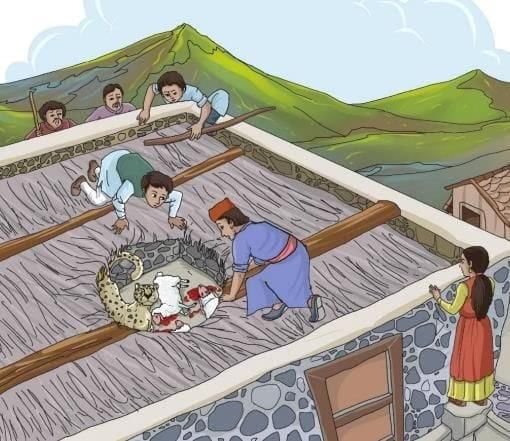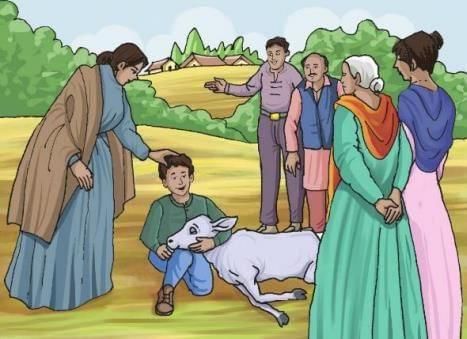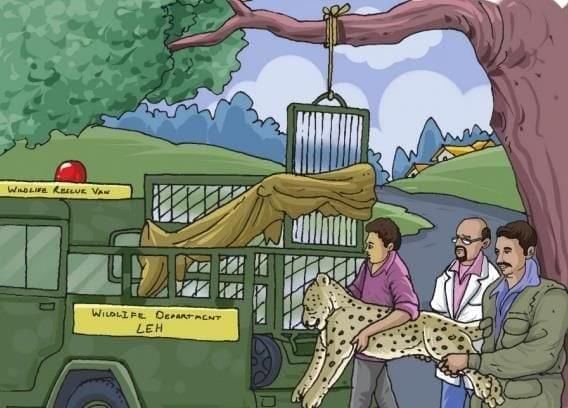The Ghost of the Mountains Chapter Notes | English Class 6 ICSE PDF Download
| Table of contents |

|
| Introduction |

|
| Key Points |

|
| Explanation |

|
| Message |

|
Introduction
"The Ghost of the Mountains" is a story set in Ang village, Ladakh, based on a true event. It follows Rigzin, a young boy, who faces a challenge when a snow leopard enters his village. Known as the ghost of the mountains, the snow leopard is a rare and shy animal. The story shows how Rigzin helps his village deal with the leopard peacefully, teaching the importance of living in harmony with nature and protecting endangered animals.

Key Points
The story takes place in Ang, Ladakh, on Buddha Purnima morning.
- Rigzin, a 16-year-old, learns a snow leopard is in Tashi’s animal enclosure (lhas).
- The leopard kills all sheep and goats but leaves a baby calf unharmed.
- Rigzin knows snow leopards are endangered, with only about 500 in India.
- Angry villagers want to kill the leopard, but Rigzin plans to save the calf.
- He distracts the leopard, rescues the calf, and escapes safely.
- Rigzin explains snow leopards are hunted for fur and bones, risking extinction.
- Villagers agree not to harm the leopard; Wildlife Department takes it to Leh.
- At the monastery, Rigzin feels happy knowing the leopard will be free.
- The author, Sujatha Padmanabhan, writes about nature and works with children.
Explanation
The story begins on Buddha Purnima morning in Ang, a small village in Ladakh, a region known for its rare snow leopards. Rigzin, a 16-year-old boy, wakes early to help prepare for prayers at the village monastery. While washing at a stream, his friend Jigmet urgently calls him to Tashi’s house, where villagers are shouting “Shan!”—the local word for snow leopard. Rigzin hurries over and finds a crowd gathered around Tashi’s lhas, an enclosure for animals like sheep, goats, and cows. Tashi’s wife, Chorol, had gone to the lhas early and heard a growl, discovering a snow leopard inside. It had killed all the sheep and goats but left a baby calf unharmed.
Rigzin climbs onto the lhas roof and peers through a hole, spotting the large snow leopard. From a nature course, he knows snow leopards are endangered, with only about 5,000 left worldwide and roughly 500 in India. These elusive animals, often called ghosts of the mountains, blend into rocky landscapes and use scents on rocks to communicate. They are protected by law, but the villagers, devastated by the loss of their livestock, are angry and want to kill the leopard. Some suggest throwing stones, while others propose using poisoned meat to eliminate the threat.

Rigzin intervenes, urging the villagers to save the calf before harming the leopard. He devises a plan to distract the leopard by creating a new hole in the roof and making noise to draw its attention. While the leopard is distracted, he will enter the lhas to rescue the calf. The villagers, including the village leader, think his plan is risky and doubt his safety, but Rigzin reassures them that snow leopards have no record of attacking humans. He enters the lhas, carefully picks up the calf, and escapes just as the leopard lunges toward him, narrowly missing. The villagers cheer his bravery and thank him for saving the calf.
Despite the rescue, the villagers remain upset, citing past losses of livestock to snow leopards. They argue that killing the leopard would protect their animals. Rigzin passionately explains that snow leopards are at risk of extinction, hunted for their fur and bones, which are sometimes used in traditional medicines as a substitute for tiger bones. Jigmet adds that poaching is a major issue, mentioning a case where a poacher was caught with over 100 animal skins, including snow leopards, tigers, and otters. Rigzin warns that if snow leopards disappear, future generations will only know them through pictures and stories.

Moved by Rigzin’s words, the villagers agree not to harm the leopard. Rigzin contacts the Wildlife Department in Leh, who send officials and a doctor. The doctor uses a tranquillizer shot through the roof hole to calm the leopard, and it is carefully carried out and taken to Leh, where officials will decide where to release it. That night, at the monastery, monks chant prayers with the scent of juniper incense filling the air. Moonlight streams through the windows, its silvery glow reminding Rigzin of the snow leopard. He smiles, content knowing the animal will soon roam free in the mountains.
Message
The story teaches that people and wild animals can coexist with care and effort. Instead of harming endangered animals like snow leopards, we should find peaceful solutions, like stronger enclosures or calling wildlife experts. Protecting nature ensures animals survive for future generations.
New Words with Meanings
- Flourish: grow or develop in a good way
- Elusive: hard to catch or find
- Predator: an animal that catches, kills, and eats other animals
- Buddha Purnima: the birth day of Gautam Buddha, founder of Buddhism, marked on full moon day in Vaisakh month (April or May) by Buddhist time
- Rosefinch: a small bird with short beak and red color on body
- Gesticulating: moving hands and arms to get notice
- Enclosure: a place closed by a wall or fence
- Livestock: animals like horses, cows, sheep kept on farms for use
- Crouching: bending low near the ground
- Endangered: in danger of no longer existing
- Camouflaged: blended with around things so hard to see because of color or form
- Distraught: very upset and worried
- Resounded: made a loud echo all over
- Hostile: not friendly, ready to fight
- Retrieve: get something back
- Chink: a small opening or crack
- Azhang-ley: Ladakhi way to call an old man with respect
- Extinct: no longer living anywhere
- Alfalfa: a plant with flowers used as food for farm animals
- Ruefully: with sadness for a mistake
- Tranquillizer: a medicine to make people or animals calm
- In unison: all together at same time
|
38 docs|19 tests
|
FAQs on The Ghost of the Mountains Chapter Notes - English Class 6 ICSE
| $1. What are the main themes explored in "The Ghost of the Mountains"? |  |
| $2. How does the story illustrate the significance of the mountains in local culture? |  |
| $3. What challenges do the characters face in relation to wildlife conservation? |  |
| $4. In what ways does "The Ghost of the Mountains" raise awareness about environmental issues? |  |
| $5. How does the author use storytelling to convey important messages about nature and conservation? |  |














